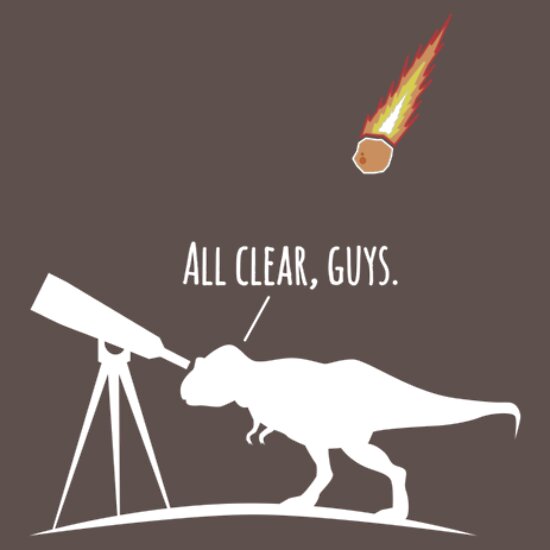Who here has seen Armageddon ? Deep Impact ? The Avengers Age of Ultron ? Gravity?
These films and many others all have a major threat, a asteroid/comet/moon/ ,we shall just say a planetary body / artificial satellite, hitting the Earth or Space craft and the resulting impact causing the destruction of Earth and the end of life as we know it, similar to what happened to the poor dinosaurs.

T-Rex was a Terrible Asteroid Hunter (alexhp RedBubble)
The process of two bodies colliding in space is known as Impact cratering and has been occurring on all planetary bodies since the very early history of the Solar System.
The resulting impact craters from these dynamic events are found on all bodies in the Solar system, including Earth, and shows a detailed volatile history of our own Solar System, and such events are still happening to day with >80 000 meteorites >10 grams impacting the Earth every Year.

Large Impact crater of Saturn’s moon of Mimas – Or the Death Star…. NASA/JPL/SSI
Here at the University of Kent we have a very special piece of equipment to investigate collisions between different materials to simulate impacts that occurred in the Solar system, we have a REALLY BIG GUN!

The Light Gas Gun at the University of Kent
It is a two stage Light Gas Gun (LGG), which can fire material up to 3 mm sq between 0.5 and 7 km/s, yes that is Kilometer per second!
Why so fast? This is to reach similar speeds to that of material in space
How does the LGG work ?
The LGG works because of the two stage mechanism, the first stage uses rifle powder within a shot gun shell similar to a normal gun. When fired the energy released from the combustion of the powder propels forward a nylon piston rather then a metal bullet.
The piston travels down the pump tube and compresses the light gas that is present. The compression of this gas builds up the pressure against the rupture disc until it finally fails and the release of pressure from the compressed gas propels the sabot containing the projectile material down a rifled launch tube through the blast tank and light curtains into the target chamber until impacting the target material.
The type of gas, usually H or He, and the initial pressure are selected to produced the required speed of the impact. The light curtains are used to calculate the speed of the projectile using the simple formula below as we know the distance between the two light curtains and the time the projectile passes thought.
Speed = Distance/Time
So why do we need to fire small things at such high speeds?
The research using the LGG at the University of Kent is diverse with impact cratering being linked to a number of different fields in space and geological sciences. We are currently investigating the possibility of living organisms surviving impact cratering events. We have also recently investigated the synthesis of amino acids from energy provided by a impact event. Check out the results HERE.
Other work includes geological changes that occur during an impact event including impact melting, loss of water.
The next Blog post will go into more detail of the research undertaken using the LGG.
So, now I hope you know why we use a big gun to investigate impact cratering events that have occurred and are occurring in the Solar System.
Need to know more? Check out these links:

